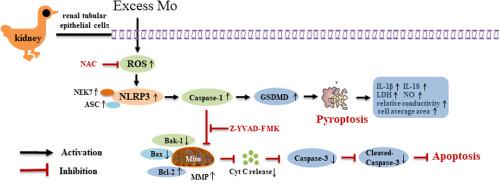Ecotoxicology and Environmental Safety ( IF 6.2 ) Pub Date : 2020-11-03 , DOI: 10.1016/j.ecoenv.2020.111528 Shaoxing Pi , Gaohui Nie , Zejing Wei , Fan Yang , Chang Wang , Chenghong Xing , Guoliang Hu , Caiying Zhang

|
Objective
Excess molybdenum (Mo) is harmful to the body, and the kidney is the vital target organ for Mo exposure. This study focused on the impacts of excess Mo on pyroptosis and the relationship between pyroptosis and apoptosis in kidney.
Methods
The duck renal tubular epithelial cells were treated with (NH4)6Mo7O24·4H2O (0, 480, 720 and 960 μM Mo), N-acetyl-L-cysteine (NAC) (100 μM), Z-YVAD-fluoromethylketone (YVAD) (10 μM) and the combination of Mo and NAC or YVAD for 12 h. The LDH release and IL-1β, IL-18 contents of cell supernatant were detected by LDH and ELISA kits. The MMP and ROS level were measured using MMP and ROS kits by flow cytometry. The apoptotic rate of cell was detected by AO/EB counterstaining. Pyroptosis and apoptosis-related factors mRNA and protein levels were assayed by real-time qPCR and western blot, respectively.
Results
Excessive Mo markedly increased LDH, IL-18, IL-1β releases and induced overproduction of ROS, pyroptosis-related factors mRNA and protein levels. NAC and YVAD dramatically decreased pyroptosis induced by Mo. Simultaneously, YVAD significantly changed apoptosis-related factors mRNA and protein levels, and reduced cell apoptotic rate.
Conclusion
Excessive Mo exposure can induce pyroptosis by the ROS/NLRP3/Caspase-1 pathway in duck renal tubular epithelial cells, and restraining pyroptosis of Caspase-1 dependence might weaken excess Mo-induced apoptosis. The study provides theoretical basis for excess Mo exposure nephrotoxic researches on waterfowl and the interplay between pyroptosis and apoptosis highlights a new sight into the mechanism of Mo-induced nephrotoxicity.
中文翻译:

抑制ROS / NLRP3 / Caspase-1介导的焦磷酸化可减轻钼诱导的鸭肾小管上皮细胞凋亡
目的
过量的钼(Mo)对身体有害,肾脏是暴露于Mo的重要靶器官。这项研究的重点是过量的钼对细胞凋亡的影响以及肾脏细胞凋亡与细胞凋亡之间的关系。
方法
用(NH 4)6 Mo 7 O 24 ·4H 2 O(0,480,720和960μMMo),N-乙酰-L-半胱氨酸(NAC)(100μM),Z处理鸭肾小管上皮细胞-YVAD-氟甲基酮(YVAD)(10μM)以及Mo和NAC或YVAD的组合持续12 h。用LDH和ELISA试剂盒检测LDH的释放以及细胞上清液中IL-1β,IL-18的含量。使用流式细胞仪使用MMP和ROS试剂盒测量MMP和ROS水平。通过AO / EB复染检测细胞的凋亡率。通过实时定量PCR和蛋白质印迹分别检测细胞凋亡和凋亡相关因子的mRNA和蛋白水平。
结果
过量的Mo显着增加LDH,IL-18,IL-1β的释放,并诱导ROS,凋亡相关因子mRNA和蛋白水平的过量生产。NAC和YVAD显着降低了Mo诱导的凋亡。同时,YVAD显着改变了凋亡相关因子的mRNA和蛋白质水平,并降低了细胞凋亡率。
结论
过量的Mo暴露可通过ROS / NLRP3 / Caspase-1途径在鸭肾小管上皮细胞中诱导焦磷酸化,而抑制Caspase-1依赖的焦磷酸化可减弱过量的Mo诱导的细胞凋亡。该研究为过量的Mo暴露于水禽的肾毒性研究提供了理论基础,并且热解与凋亡之间的相互作用突显了对Mo诱导的肾毒性机制的新认识。











































 京公网安备 11010802027423号
京公网安备 11010802027423号